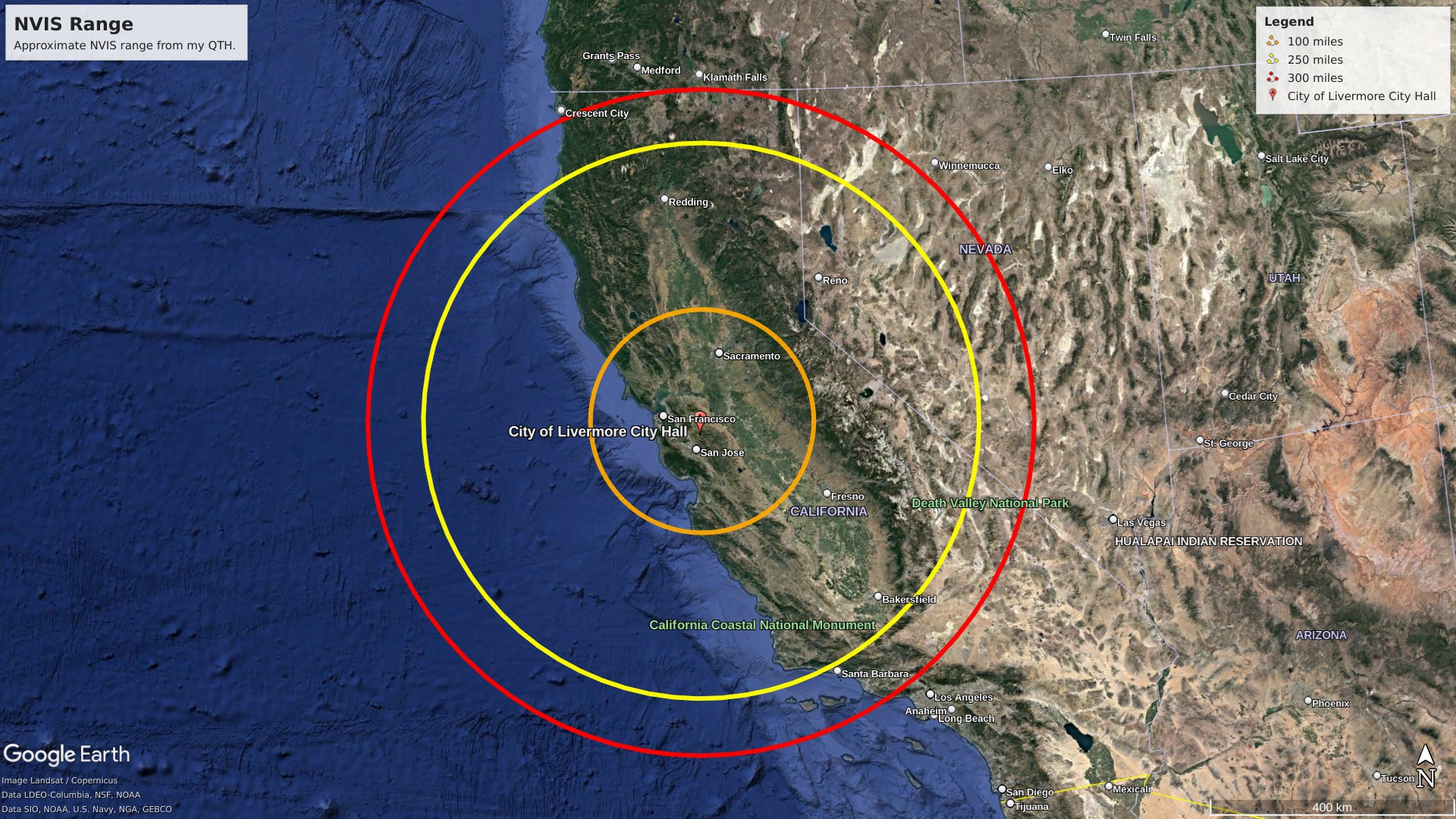NVIS notes

NVIS, or Near Vertical Incidence Skywave, is a means of HF propagation that provides signal within a medium distance range of approximately1 300 miles. The goal is to bounce a radio signal at a high angle off the ionosphere to cover the skip zone that would normally be a dead space between ground wave coverage and skywave coverage.


Frequency Selection
The actual frequencies depend a lot on conditions, but the most reliable amateur radio bands are:
- 160 meters: 1.8-2.0 MHz
- 80 meters: 3.5-4.0 MHz
- 60 meters: 5 MHz
- 40 meters: 7.0-7.3 MHz
Groundwaves are not likely to connect two radios, as terrain is virtually guaranteed to block the signal. Instead, there is a single high-angle bounce off the ionosphere:

There are some guidelines to picking a useful frequency:
- Long-haul uses higher frequencies in the 4-30 MHz range; in the day time, 10-25 MHz tends to work better while at night the lower frequencies in the 4-10 MHz range tend to work better. This uses regular skywave propagation.
- For shorter distances, NVIS frequencies should be chosen.
- In the morning or evening, 4/5 MHz is usually more effective.
- During the day time, 5-7 MHz is usually more effective.
- At night, the 1.8-3 MHz range is usually more effective.
There is a tool that we can use to figure out what is likely to be the most effective: the WWV beacons. These are time broadcasts sent out by NIST from Fort Collins, CO. They broadcast signals at 70 kW ERP on 2.5, 5, 10, 15, 20, and 25 MHz. There is also a station in Hawai’i that broadcasts on 2.5, 5, 10, and 15 MHz. By monitoring these signals, we can get a feel for what will be the most effective frequency:
| Strongest WWV frequency | Frequency range | Amateur band |
|---|---|---|
| 15/20 MHz | 6/7 MHz | 40 meters |
| 10/15 MHz | 5/6 MHz | 60 meters |
| 5/10 MHz | 3/4 | 80 meters |
| 2.5/10 MHz | 1.8-3 MHz | 160 meters |
The WWV stations send messages at specified times every hour:
| Minute | Announcement |
|---|---|
| :00 / :30 |
Station ID |
| :03 (WWVH) / :04 (WWV) | Manual changes (such as leap seconds), description of experimental signal sent at :08 |
| :08 (WWV) / :48 (WWVH) | Atmospheric propagation test signal |
| :10 (WWV) / :50 (WWVH) | DoD message, if one exists |
| :16 | Additional NIST alerts as necessary |
| :18 | Geophysical alert / conditions |
Due to the relatively low-bandwidth nature of the effective NVIS frequencies, consider using digital modes like PSK31, Olivia, or Winlink to transfer messages.
NVIS Antennas
For a field expedient NVIS antenna, an inverted ‘V’ dipole works well. However, a more robust option is a horizontal dipole a quarter wavelength above the ground, with a radial wire slightly longer than the dipole directly underneath.
The military’s NVIS antenna uses two inverted ‘V’ dipoles that also serve as the guy wires for the mast.

They also use loop antennas, aimed at a high angle towards their intended recipient, or quarter wave antennas on vehicles using tie ropes to angle the radio waves.


Some other antennas I’ve heard are the WWII-era Shirley and Jamaica antennas.
The resources page has field manuals and other docs that go a lot deeper into this topic.
- Virtually all distance measurements in radio are guaranteed to be approximate. This depends on a lot of factors, such as terrain, weather, atmospheric conditions, time of day, etc. ↩︎

| Posted in Antennas, Theory | No Comments »